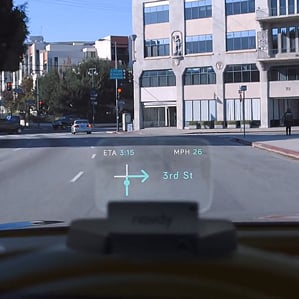This Company Thinks Your Car Wants Google Glass
If you own a smartphone, you’ve no doubt been tempted to take a look at a map or see what message just popped up on the screen while you’re behind the wheel of a car.

A startup called Navdy is building a device that will let you see such information without looking away from the road. It sits on your dashboard and can project your current speed, turn-by-turn directions, and smartphone notifications that appear to float several feet in front of you in full color.
As smartphones become more compelling, and as in-car entertainment systems cars become more distracting, new vehicle interfaces could help address driver distraction. But research has shown that even heads-up displays and voice interfaces can be distracting if they’re not carefully designed.
Market research company IHS estimates that 348,000 cars will be sold in the U.S. with heads-up displays this year, up from 247,000 in 2013. But cars with built-in systems tend to be pricey; what’s more, most heads-up displays tend to do just a few simple tasks, such as showing directions or speed. Garmin offers a $180 system that can be added to cars, but it has relatively few features and doesn’t sport a color display.
Navdy began taking orders on Tuesday for its $299 device. It is expected to ship to customers early next year.
During a recent visit to Navdy’s San Francisco office, CEO and cofounder Doug Simpson and head of sales and marketing Alex Halikias showed me how it works. It is a thin black gadget about the size of a salad plate with a curved, clear plastic screen on one end and a little opaque screen on the opposite end. To make Navdy work, data is sent via Bluetooth from a companion smartphone app (both iPhone and Android will be supported initially). A tiny projector projects the image onto a small screen that the driver looks through to see part of the road.
An infrared camera—not built into the device I saw—will let the device recognize gestures such as swiping to accept an incoming call. You can also text and tweet by gesturing to bring up a microphone and dictating a message, Simpson says. Eventually the system will be opened to outside developers, but to start it will work only with a number of apps, such as navigation apps like Google Maps and music apps like Pandora and Spotify.
Navdy might prevent drivers from fumbling with their smartphone, but research has shown that even voice controls interfere with drivers’ concentration (see “Voice Controls Can Be Surprisingly Distracting to Drivers”). Bryan Reimer, a research scientist at MIT’s AgeLab who conducted some of that work with colleagues, says that while heads-up displays can be “quite supportive” to driver attention, Navdy sounds like it’s trying to corral everything you’d do on a smartphone into a dashboard device. “One has to ask: do we really need a better way to tweet in the car?” Reimer says.
Paul Green, a research professor in the driver interface group at the University of Michigan Transportation Institute, says that whether a heads-up display is distracting depends on how it’s implemented—whether it interferes with you seeing things or is bright enough for use at night and during the day, for example.
Simpson says Navdy is following the National Highway Traffic Safety Administration’s guidelines relating to infotainment systems. “Our two goals are really: make it much safer by keeping the drivers’ eyes on the road, but then also make it a really awesome experience as well that’s much better than what we have today,” he says.
Keep Reading
Most Popular
Large language models can do jaw-dropping things. But nobody knows exactly why.
And that's a problem. Figuring it out is one of the biggest scientific puzzles of our time and a crucial step towards controlling more powerful future models.
How scientists traced a mysterious covid case back to six toilets
When wastewater surveillance turns into a hunt for a single infected individual, the ethics get tricky.
The problem with plug-in hybrids? Their drivers.
Plug-in hybrids are often sold as a transition to EVs, but new data from Europe shows we’re still underestimating the emissions they produce.
Google DeepMind’s new generative model makes Super Mario–like games from scratch
Genie learns how to control games by watching hours and hours of video. It could help train next-gen robots too.
Stay connected
Get the latest updates from
MIT Technology Review
Discover special offers, top stories, upcoming events, and more.